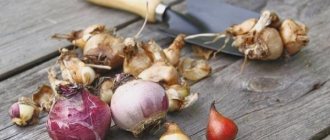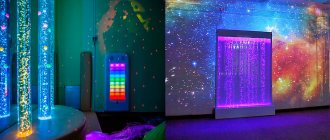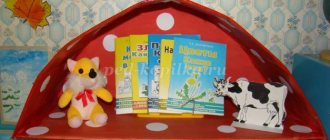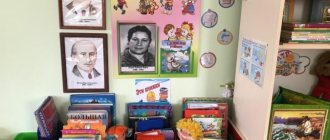What is important to consider when creating a natural corner in a kindergarten?
A living corner in a kindergarten is designed for each age group, taking into account sanitary standards, the age of the pupils and their capabilities.
SANPIN rules for preschool educational institutions 2.4.1.3049-13 clause 6.11. It has been established that placing animals, aquariums and birds in group rooms (dressing room, group room, bedroom, buffet, toilet) is not allowed.
Therefore, the main inhabitants of the corner will be plants: indoor flowers and a mini garden on the windowsill. The mini garden is made up of garlic, onions, oats and other crops grown in boxes in autumn and winter.
Requirements for the selection of plants
- Work in a corner of nature should be accessible to children in terms of time and strength, so plants are selected that are unpretentious in food and care.
- Plants should not be harmful to the health of children.
- Flowers for a corner of nature in a preschool educational institution should be selected from different types for comparison.
- When placing plants, you need to take into account their biological needs.
- The design of a corner of nature in a preschool educational institution must be done in such a way that preschool children can come up, observe, and do some work.
- Plants should have an attractive appearance that can attract and retain the unsteady attention of children.
The best corner of nature
Features of choosing indoor flowers for different groups
A corner of nature in the younger group should contain no more than 4-5 types of unpretentious indoor flowers. These are plants with distinct flowers, leaves and stems that bloom long and beautifully. Primrose, balsam, ficus, and geranium are perfect.
A corner of nature in the middle group should contain 5-6 species of plants. These are flowers with different sizes and shapes of leaves. In particular, agave, asparagus, chlorophytum.
In the corner of nature in the older group, 6 to 7 types of flowers are placed, 2 or 3 copies each. Plants must have different stems (creeping, climbing) and have bulbs or corms. These include ivy, tradescantia, amaryllis.
For the preparatory group, the number of plants is 6-7 species, which differ in the method of reproduction (bulbs, viviparous). For example, saxifrage, bryophyllum, cyperus.
When planning the design of a nature corner in a kindergarten, do not forget to provide a place to store work equipment, these could be:
- spray,
- watering can,
- cloths for wiping leaves,
- stick for loosening the soil,
- cups for seedlings.
In younger groups, the teacher monitors the cleanliness of the corner and instruments. In the senior and preparatory groups, this can be done with children (appoint a person on duty). The work of preschool children in a corner of nature is carried out in accordance with the curriculum.
Lessons in a corner of nature
Maria Skripnik works with children in the “Entertaining Zoology” and “In the Animal World” programs. During classes, the teacher tells the kids about animals, their diversity and role in nature. Children learn to care for pets, feed them, and monitor them. In addition to her classes, Maria is assigned to a zoo corner, where, as the manager and veterinarian, she monitors the health of animals, treats and cares for them, and conducts excursions for guests.
“The children and I also participate in events, holidays, promotions, conduct open classes such as “Bird Day”, “Pet Protection Day”, “Cat Day”, “Forest Day”, “Primroses”, “Feeder” campaigns, All-Russian lesson “Protected Islands of Russia”, we visit a pet store and a veterinary clinic. And in the VKontakte group “Zoo Corner” we post articles about the animal world, photos and videos of animals, classes and events of our organization,” says Maria.
Children at three to four years old and at five to six years old differ in the level of development of cognitive abilities. It’s enough for kids to simply watch fish and animals: the brighter they are, the easier it is for a child’s eye to catch on. With older children, you can grow plants from cuttings and seeds for a living corner, and study the habits of rodents and birds.
Natural corner in kindergarten: DIY decoration
When decorating a corner of nature in a preschool educational institution with your own hands, remember that it should contain a lot of visual material. The most significant of them is the nature calendar.
In a group for kids, it will be enough to place a picture depicting the current season. And also a doll dressed for the season.
For older children, there is a manual on the wall with pictures of the seasons and weather conditions with a moving arrow in the center. After the walk, you can discuss the weather with the children and move the arrow to the desired image. Also, in a corner of nature, it is necessary to set aside a place for children’s drawings on the topic of the observations made.
In older groups, children are introduced to symbols for indicating the weather. Every day, preschoolers mark weather fluctuations with conventional signs and at the end of the month they sum up the results: how many days were cloudy, how many sunny, windy, rainy. By the end of the year, the children will have an idea of the climate in their region.
A beautiful corner of nature in kindergarten
Often, a natural and ecological corner in a kindergarten is combined into one and, in addition to the above, the following is placed in it:
- a set of pictures with birds, insects, domestic and wild animals, plants;
- dummies of vegetables and fruits;
- children's crafts made from natural materials;
- equipment for conducting experiments - molds, containers of different volumes, spatulas, measuring spoons. You can conduct didactic games and experiments with water, sand, stones, shells, and clay to study their properties.
Activities in a corner of nature contribute to the development of work skills in preschool children. Already in the younger group, the teacher involves children in carrying out feasible work assignments. In the older group, corner duty is introduced.
Working in a corner of nature gives children a lot of pleasant experiences. Preschoolers learn to understand the world around them, to notice both general and individual signs of natural objects, which leads them to an understanding of the uniqueness and diversity of living organisms. Communication with nature stimulates children's thirst for creativity. A properly organized living corner is a powerful educational tool in the aesthetic, psychological and moral development of children.
Nature center at preschool educational institution
Tatiana Galashova
Nature center at preschool educational institution
Consultation for educators
Nature Center in a group
Prepared by senior teacher
Galashova Tatyana Vasilievna
Slide 1.
natural world cannot be known from a picture. In order for a preschooler to learn to understand the world around him, to realize what is part of it, to establish connections between natural , it is necessary to immerse the child in the appropriate atmosphere. As part of the activities of the preschool educational institution, this is possible by creating various nature centers in the group .
Slide 2.
The nature center is one of the play and learning areas of the group room.
A corner of nature that fits organically into the interior will decorate the group room and allow children to conduct observations and experimental activities. In addition, preschoolers are instilled with feelings such as responsibility and care, as children learn to care for animals and plants.
Slide 3.
Nature Center Meaning :
• Communication with nature has a positive effect on the child.
• The ability to get a good look at an object and observe it for a long time.
• Development of cognitive processes.
• Formation of labor skills and diligence.
The educational value of nature is difficult to overestimate . Communication with nature has a positive effect on a person, makes him kinder, softer, and awakens better feelings in him. The role of nature is especially great in raising children . Introducing children to nature requires constant direct communication with it.
In the nature center, children have the opportunity to get a good look at the plants and observe them for a long time. While working in the nature center, children develop cognitive processes: perception, thinking, imagination, memory. Children establish cause-and-effect relationships, remember the names of the inhabitants, and come up with games using objects from the nature center .
While caring for the inhabitants of the nature center, children develop work skills and such valuable qualities as hard work, caring for living things, and responsibility for the assigned work.
Slide 4.
Objectives of the nature center :
• The younger group - to develop an interest in plants and animals, to cultivate a caring, caring attitude on the part of humans.
• Middle group - to form the first ideas about the plant as a living organism; teach to establish simple relationships and dependencies in the natural ; introduce plant species.
• Senior group - introduce plants of different climatic zones, with different care (different stems, without stems)
Carrying out pedagogical work in the nature center will allow children to see:
• the inextricable connection of a living organism with the external environment,
• multifunctional adaptability to certain elements of the environment,
• the emergence of a new organism, its growth, development and conditions that ensure these processes,
• specificity of a living organism, its difference from objects,
• diversity of living organisms and different ways of interacting with the environment and much more.
Slide 5.
To fulfill its role, the nature center in a preschool educational institution must meet certain requirements:
• Better less, but better - that is, use a small number of objects, but healthy, well-groomed and beautifully fit into the interior of the room
• When organizing a nature center, be sure to find out whether children are allergic to certain plants or animals
• The selected objects must be beautiful, typical, with clearly defined characteristics
• Plants and animals must be safe for children, i.e. not poisonous, without thorns, not aggressive, etc.
• The inhabitants of the nature center should be unpretentious and easy to care for. It is imperative to carry out daily plant care.
• The selection of plants and animals is carried out taking into account the age characteristics of children, guided by the General Educational Inspectorate and SanPiN. It is advisable to have nameplates on the flowers.
• Racks and shelves must be secured
• Plant care equipment (loosening sticks, sponges, cloths)
located in containers with lockable lids
• Natural material should be placed in containers in accessible quantities
• Equipment for experiments must be safe
• Each group should have a nature
Slide 6.
Due to the fact that Sanitary and Epidemiological Rules and Standards SanPiN 2.4.1.3049-13 clause 6.11. It is not allowed to place aquariums, animals, birds in group rooms; only plants are placed here.
Indoor plants have been decorating human homes for a long time. Some of them bloom profusely and for a long time, others have beautiful foliage, their stems are varied (erect, curly, recumbent, ascending, etc.)
.
Most indoor plants come from tropical and subtropical countries, hot deserts and savannas, tropical rainforests and swamps, mountain slopes and valleys. Depending on where they grow in nature , indoor plants require different care (different soil, watering, degree of light, etc.)
.
Indoor plants are also interesting because each species has its own timing and periods of active growing season.
Indoor plants are valuable teaching material; they are obligatory inhabitants of the nature center .
Slide 7.
All inhabitants of the nature center in the kindergarten can be divided into permanent and temporary.
Permanent inhabitants of this corner of nature will be indoor plants:
• In the younger group, 4-5 types of unpretentious plants are recommended for indoor plants. These are plants that bloom beautifully and for a long time, with distinct stems, leaves and flowers. For example, ficus, primrose, balsam, coleus, geranium.
• In the middle group, the number of indoor plants increases to 5-6 species. These will be plants with different shapes and sizes of leaves. For example, asparagus, agave, chlorophytum.
• In the older group, 6-7 plant species, 2-3 specimens each, with various stems (climbing, creeping, having bulbs and corms. For example, tradescantia, ivy, amaryllis and others are placed of nature
• In the preparatory group, 6-7 species of plants are placed in a corner of nature , which reproduce in various ways: by bulbs, viviparous. As well as flowers with different growing conditions. For example, bryophyllum, saxifrage, cyperus.
Slide 8.
Temporary inhabitants of a corner of nature are objects that are brought in for observation for a short period of time:
• In the fall, these will be autumn bouquets and flowers from the flower garden, transplanted into flowerpots. And also in older groups, crafts made from natural materials .
• In winter, these can be boxes with green onions and tree branches.
• In spring – boxes with seedlings for the kindergarten garden, bouquets of spring primroses.
• For short-term observation, you can bring a fish in a jar, a hamster, or a bird in a cage to the group. Of course, if the kindergarten space allows, then you can organize an ecological room. It will house plants and animals, birds and reptiles, the observation of which is suggested by the Education Program.
Slide 9.
Can be made dry
aquarium.
To do this, you need to fill the aquarium with colored pebbles, glue wallpaper with an image of the underwater world on the back wall, place toy sea inhabitants (turtle, crayfish, crab and others) on the bottom, stick 3D fish stickers on the back wall from the inside of the aquarium, and snail stickers on the pebbles , starfish. Supplement the seascape with artificial algae. The aquarium is ready.
Slide 10.
It is recommended that each kindergarten group have a weather calendar. By marking the weather on a calendar, children consolidate knowledge gained from observations in nature .
• In the younger group, you can hang a picture depicting the season, for example, an autumn landscape. And in a corner of nature there is always a doll dressed for the season.
• In the middle group, this could be a manual on which pictures are drawn depicting weather conditions with a moving arrow in the middle. After returning from a walk and discussing the weather, the children move the arrow to the desired picture. Children's drawings on the theme of observations are also placed in the nature
• In the senior and preparatory groups, children become familiar with symbols for indicating the weather. The children mark the weather with symbols every day. At the end of the month, the weather conditions are compared, they count how many clear, cloudy, rainy and windy days there were, and draw conclusions about the weather.
Slide 11.
In addition, in a corner of nature in each group it is necessary to have:
• Natural vegetables and fruits, or their dummies.
• Sets of pictures depicting animals, birds, insects, etc.
• Albums “Seasons”
; books with illustrations depicting animals; paintings by famous artists.
• Children's drawings about nature and crafts made from natural materials .
• Material for labor. Aprons, watering cans, spatulas, loosening sticks, and rags are useful for caring for indoor plants. Brooms and dustpans - to maintain cleanliness in a corner of nature and a group .
• Equipment for experiments. Molds, funnels, shovels, sieves will be needed for playing with sand. To play with water, you can use pipettes, disposable syringes, and containers of various shapes. To make crafts, you need natural and waste materials (shells, pebbles, pine cones, acorns, chestnuts, twigs)
. For children in the preparatory group, working with a magnifying glass, microscope, and scales will be interesting.
• Didactic games with natural content “Who eats what?”
,
“Whose house?”
,
“Whose baby?”
and others.
Slide 12.
Filling with the necessary material depends on age and on the requirements of the program. Designing a nature center requires the teacher to have knowledge of the program and methodology for introducing children to nature , as well as aesthetic taste. In addition, he must love nature and treat it with care.
But it is not the presence of a nature center in the group that will make the process of introducing children to nature effective , but the organization of activities to fill it and use it in the course of educational work.
Slide 13.
The nature center is not just for observing. It also contributes to the formation of labor skills. Already from the younger group, children are involved in carrying out individual work assignments. And from the senior group on duty in a corner of nature .
Slide 14.
Thus, the nature center is needed not only as a group setting, but is also a necessary component of the pedagogical process in a preschool institution.
Natural corner in kindergarten (photo)
Which animals to choose
“In our living area there are mainly unpretentious pets: Syrian and Djungarian hamsters, rats, gerbil mice, akomis spiny mice, rabbits, guinea pigs, budgies, and fish,” says Maria Skripnik. “But there are also those who need to create special conditions for a full life: Central Asian and red-eared turtles, chinchillas, degus, Achatina snails.”
Who can be accommodated in a zoo corner?
Fish
It is useful to choose fish of different breeds so that children can compare them and find differences. The most unpretentious breeds are considered to be guppies, swordtails, barbs, cardinals, zebrafish, catfish, and goldfish. It is better to place the aquarium in a cool, dark place away from the window.
Some types of fish cannot be kept in the same aquarium. For example, schooling barb fish do not get along well with smaller breeds (they simply eat them or bite off their fins), and also conflict with goldfish. The best neighbors for them will be swordtails, zebrafish, and parrotfish.
In addition, it is necessary to take into account the purity, hardness and acidity of the water. Guppies cannot stand dirt in an aquarium, so they do not get along well with goldfish. You should find out about all this in advance from a consultant at a pet store and read in specialized literature.
Reptiles
An interesting exhibit is a chameleon. By watching him, children learn about the phenomenon of mimicry. Land and waterfowl turtles will take root in the zoo corner.
“But turtles require a large aquarium or cage, an ultraviolet lamp for heating, and special food,” warns Maria Skripnik.
Waterfowl require an aquarium with rocks. Moreover, some of the stones should be located above the water so that the turtles can crawl onto land and bask under the lamp.
Rodents
It is allowed to keep rabbits, guinea pigs, mice, rats, and hamsters in the zoo corner of a preschool institution. Maria Skripnik says that each type has its own characteristics of content:
“For rabbits, rats, and guinea pigs, you have to clean the cage often and feed a lot. But spiny mice do not require frequent changes of bedding, they drink little, are unpretentious in food, but they love to live in the company of their relatives. Hamsters, on the contrary, prefer to live alone. They don't need a large cage, they don't eat much, and they're easy to care for. Some animals (hamsters, chinchillas, rats, Achatina snails) are more active at night and sleep during the day - it’s more interesting to watch them in the evening.”
If rodents live in cages, then they should be placed at a short distance so that the inhabitants of neighboring cages cannot injure each other. If animals are kept in aquariums, there is no such need.
Living corner in MBU DO "CD (Yu)TT" Salavat
Birds
Usually the zoo's corner is home to budgies, canaries, rosellas, cockatiels, and greenfinches. They are easy to care for, have bright colors and are popular with children. In addition, some species breed in captivity, which means kids will be able to watch the emergence and growth of chicks. There are species of parrots that exhibit strong sexual dimorphism—the difference in appearance between males and females. This is also a topic for class.
Plants
Plants can be conveniently divided into climatic zones. For example, imagine the tropical zone with ficus, chamedorea. The desert - aloe and other succulents, the subtropics - azaleas and geraniums.
During classes in the zoo corner, the child is involved in various types of activities: play, work, observation, discussion. This promotes comprehensive, diversified development. A living corner will give preschoolers extensive knowledge about nature and instill a love for the world around them. Getting acquainted with living nature, the child will develop morally, spiritually and aesthetically.









